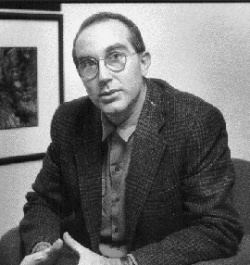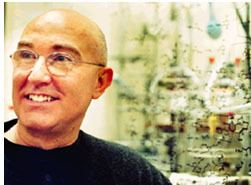Known for Organic Synthesis Name Stuart Schreiber | Fields Chemical biology | |
 | ||
Born February 6, 1956 ( 1956-02-06 ) Notable awards ACS Award in Pure Chemistry (1989)Ciba-Geigy Drew Award for Biomedical Research (1992) Education University of Virginia, Harvard University Similar Yoshito Kishi, Craig M. Crews, Robert Burns Woodward | ||
Stuart Schreiber - Core Institute Member
Stuart L. Schreiber (born 6 February 1956) is a scientist at Harvard University and co-Founder of the Broad Institute. He has been a pioneer in chemical biology for over 30 years. His name is closely associated with the increasingly common use of small molecules as probes of biology and medicine. Small molecules are the molecules of life most associated with dynamic information flow; these work in concert with the macromolecules (DNA, RNA, proteins) that are the basis for inherited information flow. During the 1980s, 1990s, and the past 20 years, he provided dramatic advances in biology using this approach, and, in the past ten years, his systematization efforts have made this one of the fastest growing areas of life-science research.
Contents
- Stuart Schreiber Core Institute Member
- Education and Training
- Key discoveries 1980s and 1990s
- Advancing chemical biology in the 21st century
- Current research
- Selected Awards
- Personal life
- References

Education and Training

Schreiber obtained a Bachelor of Science degree in Chemistry from the University of Virginia in 1977, after which he entered Harvard University as a graduate student in Chemistry. He joined the research group of Robert B. Woodward and after Woodward's death continued his studies under the supervision of Yoshito Kishi. In 1980, he joined the faculty of Yale University as an assistant professor in Chemistry, and in 1988 he moved to Harvard University as the Morris Loeb Professor.
Key discoveries, 1980s and 1990s

Schreiber started his research work in organic synthesis, pioneering concepts such as the use of photocycloaddition to establish stereochemistry in complex molecules, the fragmentation of hydroperoxides to produce macrolides, ancillary stereocontrol, group selectivity and two-directional synthesis. Notable accomplishments include the total syntheses of complex natural products such as talaromycin B, asteltoxin, avenaciolide, gloeosporone, hikizimicin, mycoticin A, epoxydictymene and the immunosuppressant FK-506.

Following his co-discovery of the FK506-binding protein FKBP12 in 1988, Schreiber reported that the small molecules FK506 and cyclosporin inhibit the activity of the phosphatase calcineurin by forming the ternary complexes FKBP12-FK506-calcineurin and cyclophilin-ciclosporin-calcineurin. This work, together with work by Gerald Crabtree at Stanford University concerning the NFAT proteins, led to the elucidation of the calcium-calcineurin-NFAT signaling pathway. This landmark discovery, an early example of defining an entire cellular signaling pathway from the cell surface to the nucleus, can be appreciated when it is considered that the Ras-Raf-MAPK pathway was not elucidated for another year.

In 1993, Schreiber and Crabtree developed "small-molecule dimerizers", which provide small-molecule activation over numerous signaling molecules and pathways (e.g., the Fas, insulin, TGFβ and T-cell receptors) through proximity effects. Schreiber and Crabtree demonstrated that small molecules could activate a signaling pathway in an animal with temporal and spatial control. Dimerizer kits have been distributed freely resulting in many peer-reviewed publications. Its promise in gene therapy has been highlighted by the ability of a small molecule to activate a small-molecule regulated EPO receptor and to induce erythropoiesis (Ariad Pharmaceuticals, Inc.), and more recently in human clinical trials for treatment of graft-vs-host disease.

In 1994, Schreiber and co-workers co-discovered (independently co-discovered by David Sabitini) the master regulator of nutrient sensing, mTOR. They discovered that the small molecule rapamycin simultaneously binds FKBP12 and mTOR (originally named FKBP12-rapamycin binding protein, FRAP). Using diversity-oriented synthesis and small-molecule screening, Schreiber helped illuminate the nutrient-response signaling network involving TOR proteins in yeast and mTOR in mammalian cells. Small molecules such as uretupamine and rapamycin were shown to be particularly effective in revealing the ability of proteins such as mTOR, Tor1p, Tor2p, and Ure2p to receive multiple inputs and to process them appropriately towards multiple outputs (in analogy to multi-channel processors). Several pharmaceutical companies are now targeting the nutrient-signaling network for the treatment of several forms of cancer, including solid tumors.
In 1995, Schreiber and co-workers discovered that the small molecule lactacystin binds and inhibits specific catalytic subunits of the proteasome, a protein complex responsible for the bulk of proteolysis in the cell, as well as proteolytic activation of certain protein substrates. Lactacysin was the first non-peptidic proteasome inhibitor discovered and has become a major tool for the study of proteasome function in biochemistry and cell biology. Lactacystin modifies the amino-terminal threonine of specific proteasome subunits. This discovery helped to establish the proteasome as a mechanistically novel class of protease: an amino-terminal threonine protease, and it led to the discovery of bortezomib, used to treat multiple myeloma.
In 1996, Schreiber and co-workers used the small molecules trapoxin and depudecin to discover the histone deacetylases (HDACs). Prior to Schreiber’s work in this area, the HDAC proteins had not been isolated – despite many attempts by others in the field who had been inspired by Allfrey's detection of the enzymatic activity in cell extracts over 30 years earlier. Coincident with the HDAC discovery, David Allis and colleagues reported their discovery of the histone acetyltransferases (HATs). These two contributions catalyzed much research in this area, eventually leading to the characterization of numerous histone-modifying enzymes, their resulting histone “marks”, and numerous proteins that bind to these marks. By taking a global approach to understanding chromatin function, Schreiber proposed a “signaling network model” of chromatin and compared it to an alternative view, the “histone code hypothesis” presented by Strahl and Allis. These studies shined a bright light on chromatin as a key gene expression regulatory element rather than simply a structural element used for DNA compaction.
Advancing chemical biology in the 21st century
During the past 20 years, Schreiber has attempted to systematize the application of small molecules to biology through the development of technologies that inclue diversity-oriented synthesis (DOS), chemical genetics, and ChemBank. Schreiber has shown that DOS can produce small molecules distributed in defined ways in chemical space by virtue of their different skeletons and stereochemistry, and that it can provide chemical handles on products anticipating the need for follow-up chemistry using, for example, combinatorial synthesis and the so-called Build/Couple/Pair strategy of modular chemical synthesis. DOS pathways and new techniques for small-molecule screening provided many new, potentially disruptive insights into biology. For example, Schreiber and collaborator Tim Mitchison used cytoblot screening to discover monastrol – the first small-molecule inhibitor of mitosis that does not target tubulin. Monastrol was shown to inhibit kinesin-5, a motor protein and was used to gain new insights into the functions of kinesin-5. This work led pharmaceutical company Merck, among others, to pursue anti-cancer drugs that target human kinesin-5. Small-molecule probes of histone and tubulin deacetylases, transcription factors, cytoplasmic anchoring proteins, developmental signaling proteins (e.g., histacin, tubacin, haptamide, uretupamine, concentramide, and calmodulophilin), among many others, have been discovered in the Schreiber lab using diversity-oriented synthesis and chemical genetics. Multidimensional screening was introduced in 2002 and has provided insights into tumorigenesis, cell polarity, and chemical space, among others.
Schreiber’s laboratory has served as a focal point for the field of chemical biology, first by the ad hoc use of small molecules to study three specific areas of biology, and then through the more general application of small molecules in biomedical research. As a principal advocate for chemical biology, he has influenced the public and private research communities. Academic screening centers have been created that emulate the Harvard Institute of Chemistry and Cell Biology and the Broad Institute; in the U.S., there has been a nationwide effort to expand this capability via the government-sponsored NIH Road Map. Chemistry departments have changed their names to include the term chemical biology and new journals have been introduced (Cell Chemical Biology, ChemBioChem, Nature Chemical Biology, ACS Chemical Biology) to cover the field. Schreiber has been involved in the founding of numerous biopharmaceutical companies whose research relies on chemical biology: Vertex Pharmaceuticals, Inc. (VRTX), Ariad Pharmaceuticals, Inc. (ARIA), Infinity Pharmaceuticals, Inc (INFI), Forma Therapeutics, H3 Biomedicine and Jnana Therapeutics. These companies have produced new therapeutics in several disease areas, including cystic fibrosis and cancer.
Current research
Schreiber’s development of diversity-oriented synthesis has led to the discovery of many promising agents, including a novel mechanism of action anti-malarial agent being developed in collaboration with the pharmaceutical company Eisai. His most recent discovery revealed a novel cell state responsible for the ability of cancers to resist a wide range of therapies, and a means to target the cancer therapy-resistant state. His research has been reported in over 600 publications (H index = 138) and recognized through numerous awards, most recently the Arthur C. Cope Award and the Wolf Prize in Chemistry.
Selected Awards
Personal life
Schreiber has been married since 1981 to Mimi S. Packman and enjoys traveling and riding bikes with her.
